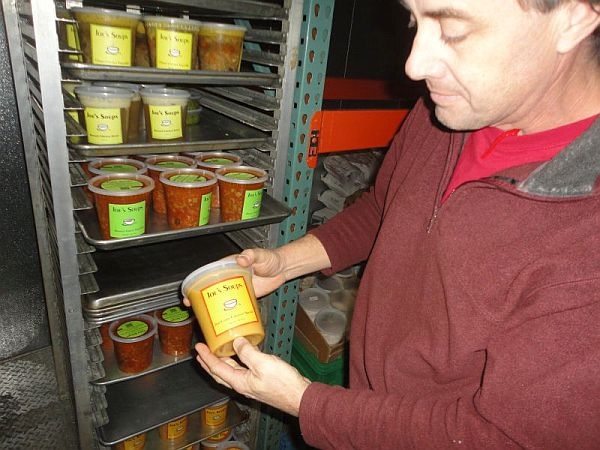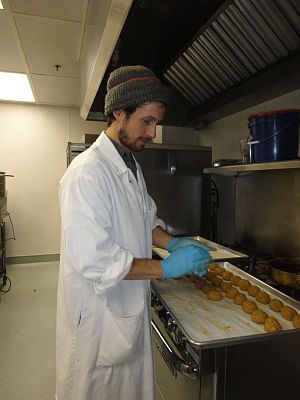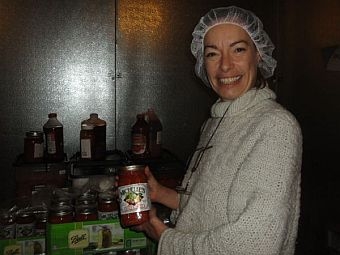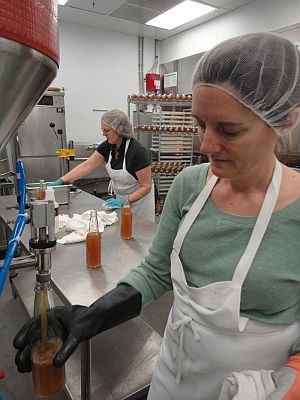 The history of Vermont agriculture is a record of change.
The history of Vermont agriculture is a record of change.
In recent times the state’s farm economy has been based on milk production. But the face of farming is changing.
As dairy farms decline in number, the state’s developing food economy is playing a larger role in the effort to sustain the working landscape.
One sign is the growing number of small food producers.
For farmer Joe Buley, farming is as much about making soup as growing vegetables.In fact, Buley’s burgeoning soup business is about to outstrip his income from farmer’s markets and his CSA. Buley is making the soup from his vegetables.
"As the soup business has grown, we’ve gone from 10% of my gross to 20%," says Buley "Right now its 50-50 between value added and raw farm product and it’s going to probably keep shifting toward the value-added end."
For a dairy farmer value added might mean making cheese, yogurt or ice cream. Vermont Agriculture Secretary Chuck Ross says it’s all part of a trend.
 "Clearly we’ve been seeing in recent years the development of a whole value-added component to Vermont agriculture that has grown in significance. It’s been marked by Cabot cheese, it’s been marked by the rise of artisanal cheese," says Ross.
"Clearly we’ve been seeing in recent years the development of a whole value-added component to Vermont agriculture that has grown in significance. It’s been marked by Cabot cheese, it’s been marked by the rise of artisanal cheese," says Ross.
Ross says dairy is still king. But value added products, specialty foods, farm to plate programs and all the non-dairy farm enterprises together are now a significant part of Vermont’s farm economy.
A new infrastructure is growing up around value added production and the burgeoning number of off-farm specialty food businesses that use Vermont grown ingredients.
For soup maker Joe Buley, renting space at the Mad River Food Hub means he no longer uses the kitchen of a local church. He can process, package, store and ship his products in one place.
The food hub’s warehouse-sized building in Waitsfield has storage space, a commercial kitchen and processing rooms. It’s the only USDA inspected facility in the Northeast where producers can rent space to process meat.
"Not only can you do the rudimentary processing of meat products, you can then add value to them. You can make sausage here, you can make pork chops. You can take that product into the kitchen and you can make chili, you can make somosas, you can make any product you like,"explains operations manager Jacob Finsen.
The food hub is in the process of adding a meat curing facility and Finsen says the 15 month old hub is just about at the break even point financially.
Joe Bossen of Vermont Bean Crafters uses the hub to make falafel.
Bossen is trying to improve on the percentage of locally grown ingredients in his product.
"We’re working on that," he says. "But in order to make the price points work for everyone we had to settle on somewhere between 50 percent and 30 percent."
Finding the right price point is a balancing act for specialty food producers. Local sourcing isn’t always the least expensive option.
Supply can be another limiting factor.
 Michelle Guenard makes Michelle’s Spicy Kimchi, which she describes as a combination of salsa and sauerkraut.
Michelle Guenard makes Michelle’s Spicy Kimchi, which she describes as a combination of salsa and sauerkraut.
Only about 10% of Guenard’s product comes from local farms. She says they simply aren’t growing what she needs.
"Teeny tiny cute organic vegetables are what people are growing because they can make more money at it. I need huge onions. I need huge carrots. I can’t peel 1,000 itsy bitsy carrots," Guenard explains.
Guenard has turned to smaller, less established growers. She’s getting them to experiment with a particular kind of cabbage she needs.
"I had four different growers testing Napa cabbage for me this year," she says.
Guenard helped found a network of Northeast Kingdom growers and producers which met for the first time earlier this year.
Guenard processes, packs, stores and ships her kimchi at the Vermont Food Venture Center in Hardwick.
Like the Mad River Food Hub, the venture center is a new facility helping to incubate specialty food businesses, helping them not only with production but with business planning.
Guenard’s difficulty finding local sources for her kimchi ingredients isn’t unusual.
Elena Gustavson is interim executive director of the non-profit that operates the venture center. Gustafson says more specialty producers are doing what Guenard has done and working directly with farmers.
"We’re starting to see those conversations happen more and more and we can only expect that the demand for local product will create an environment where farmers will want to grow specifically for a product,"Gustavson explains.
 Susan Alexander makes switchel, a maple syrup and cider vinegar refreshment from an earlier time.
Susan Alexander makes switchel, a maple syrup and cider vinegar refreshment from an earlier time.
Alexander turns out 800 bottles of switchel in a day at the venture center. Her six month old business is poised to grow if she has the right equipment.
"I need to get out of doing 800 bottles a day and get up to doing 1,000, 2,000, 3,000. Ideally, I’m looking at doing 4,000 bottles every time we do a run, but I can’t do that with this," says Alexander as she painstakingly fills each bottle by hand.
Taking a business like Alexander’s to the next level requires hard-to-find capital to purchase equipment. Retailers that carry specialty food products have their own set of requirements that can be expensive to meet.
The growth of value-added and specialty foods continues to generate new programs and infrastructure.
Plans are in the works to open a new processing facility in Chittenden County.
Vermont Technical College recently unveiled a program to teach value added production, and there are new grants for producers under the state’s newly established Working Lands Enterprise Initiative.
Whether or not to grow her business is a financial decision for Susan Alexander, but something more than profit motivates her and other specialty food producers.
"It’s not just about me making some money," she explains. "It’s about our agrarian heritage. But it’s also about the resources we use, where we get them from, how far we transport them."
Alexander hopes her success translates into a stronger, more diversified farm economy for Vermont.